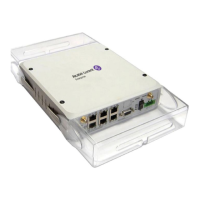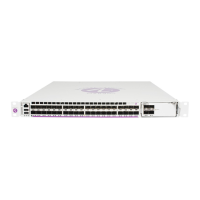7705 SAR Interfaces
7705 SAR OS Interface Configuration Guide Page 37
Network Synchronization on Ports
The 7705 SAR provides network synchronization on T1/E1, SONET/SDH, and Ethernet
ports as described in the sections that follow.
Network Synchronization on T1/E1 and Ethernet Ports
T1/E1 ports or synchronous Ethernet ports configured for line timing provide the best
synchronization performance through a synchronization distribution network. Line timing
mode derives an 8 KHz clock from the framing of T1/E1 that can be used as an accurate
reference for nodes in a network. This mode is immune to any packet delay variation (PDV)
occurring on Layer 2 or Layer 3 links. Line timing is supported on the 7705 SAR-F T1/E1
ports and Ethernet SFP ports with SFPs that support Synchronous Ethernet. On the
7705 SAR-8, line timing is supported by the 16-port ASAP Adapter card and by the 8-port
Ethernet v2 card on two Ethernet SFP ports with SFPs that support Synchronous Ethernet.
Synchronous Ethernet is a variant of line timing supported on the 7705 SAR-8 with an
Ethernet v2 Adapter card and on the 7705 SAR-F on Ethernet SFP ports with SFPs that
support Synchronous Ethernet. When synchronous Ethernet is enabled, the operator can
select an Ethernet port as a candidate timing reference. The recovered timing from this port
is then used to time the system. This ensures that any of the system outputs are locked to a
stable, traceable frequency source.
Network Synchronization on SONET/SDH Ports
Each SONET/SDH port can be looped-timed (that is, recovered from an Rx line) or
node-timed (that is, recovered from the SSU in the active CSM).
A SONET/SDH port’s receive clock rate can be used as a synchronization source for the
node.
Flow Control on Ethernet Ports
IEEE 802.3x Flow Control, which is the process of pausing the transmission based on
received pause frames, is supported on Fast Ethernet and Gigabit Ethernet ports. In the
transmit direction, the Ethernet ports generate pause frames if the buffer occupancy reaches
critical values or if port FIFOs are overloaded. Pause frame generation is automatically
handled by the Ethernet Adapter card when the system-wide constant thresholds are
exceeded. The generation of pause frames ensures that newly arriving frames still can be
processed and queued, mainly to maintain the SLA agreements.

